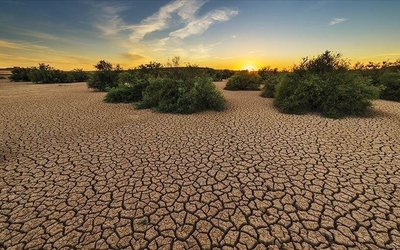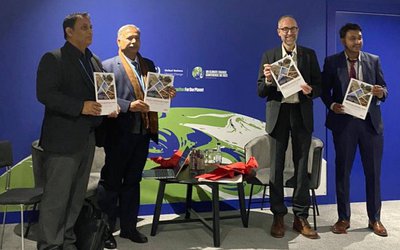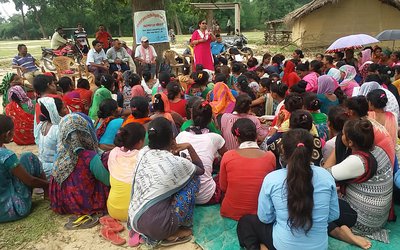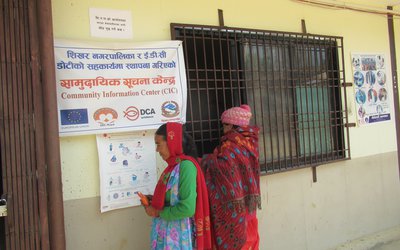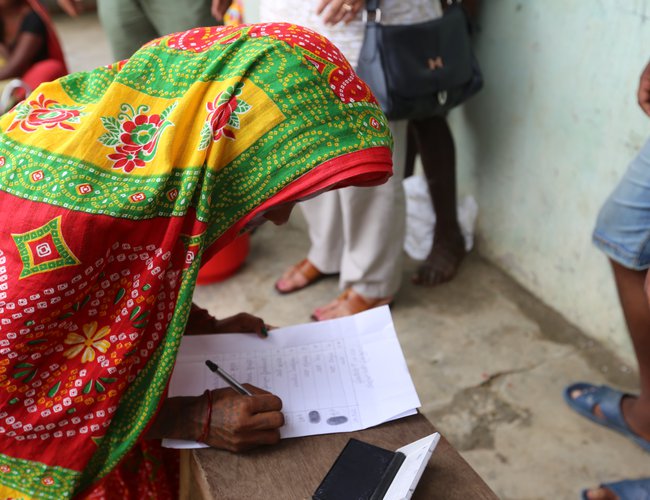
Unlike previous years, Sunar Bati BK, a seventy-five-year-old resident of Umar Tole of Saptakoshi Municipality Ward 3, did not have to face difficulty as the cold wave hit his family this year.
With the support from DCA’s and its local partner Koshi Victim’s Society (KVS) and close collaboration with Saptakoshi Municipality, BK receives NPR. 2000 to purchase clothes and essentials foodstuffs to feed his family of six.
BK, who belongs to the Dalit community, a historically marginalized and vulnerable group, had a bitter experience two years ago when his five-year-old grandson was hospitalized due to the cold. “It was a really tough time for our family. We didn’t have money to purchase food and warm blanket and clothes,” recalled BK. “This year, we received everything within a week of a cold wave hitting our area”.
BK and his family are among the 460 households (229 male and 231 female) from 11 wards in the Saptakoshi Municipality of the Saptari District who received the NPR.2000 support.
The support was provided through cash transfer, using the existing ‘Social Protection (SP)’ system for cold wave response of the Saptakoshi Municipality. This combination of using cash transfer and integrating it with an existing social protection system is a pilot project initiated by DCA in collaboration with the Saptakoshi Municipality.
80 years old Ganekhi Sada, a resident of Ward No. 3 of Saptakoshi Municipality stated, “In the past, the months of December to February, was a difficult time for me and my family. I always worried about not having enough food to survive during the winters. But the NPR 2000 cash really helped us.” Of his family of six, Ganekhi Sada’s son is the only earning member. “This winter, my son couldn’t go to work. The NPR 2000 might have seemed like a small amount, but it was lifesaving for my family. We bought food for the family with the money,” informed Sada.
The integrated social registry along with the vulnerability index at the household level to hazards made it easier to target beneficiaries during emergencies. Cash transfer was provided through the banking system.
73-years old Ghichne Devi Chaudhary, a resident of Utter Tole of Ward no 3 of Saptakoshi municipality, stated, " I received Rs. 2000.00 in my bank account opened for social protection. I used the money to purchase warm clothes and a blanket.”
"Among others, the impoverished communities are at the receiving end of the harsh cold weather," stated Biswash Pokharel social protection mobilizer at Saptakoshi Municipality.
Most of the poor people live in shacks built on unregistered land which is unsafe and lacks basic amenities, increasing the risk of health ailments. "We had seen the cases of pneumonia, diarrhea, and common cold patients,” informed Pokharel.
The municipality carried out the distribution of relief and cash packages on a random basis, and there might be a chance of the relief packages not reaching the cold-wave affected population. This has been reported by the media as well.
“This pilot for Shock Responsive Social Protection (SRSP), opens up opportunities to collaborate with INGOs like DCA and local NGO like KVS, by using our SP to reach the disaster-affected population, " stated Uttam Kumar Sharma, Mayor of Saptakoshi Municipality.
Through the pilot, Saptakoshi Municipality plans to integrate data collection of social protection for shock response.
According to spokesperson Shiva Raj Joshi of the Department of National ID and Civil Registration, 398 local level governments now have an online payment system to distribute the Social Protection Benefits. Over 3.1 million people have been receiving the SP through the online banking system. " Our data can be used for all the purposes including disaster response,” informed Joshi."
Although it was implemented on a small scale, DCA with its local partner KVS and the Saptakoshi Municipality mapped the Vulnerability Index at a household level to areas that are vulnerable to hazards such as flood, cold wave, and others. With the pre-disaster database which includes SP and households and their vulnerabilities in one system, in any event, the municipality can quickly release assistance in the form of cash.
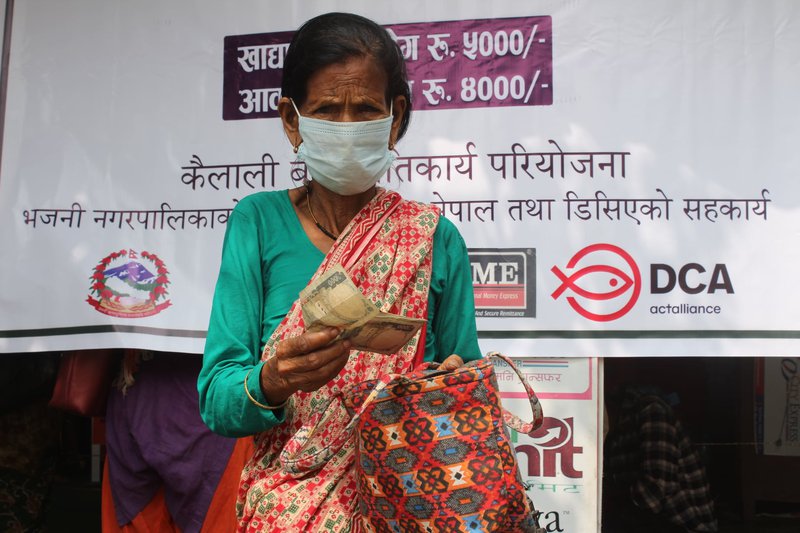
Along with cash, DCA also provided technical support to the Saptakoshi Municipality for developing Cash Voucher Assistance guideline (CVA), capacity development, and operational management support to deliver cash.
“Through the pilot initiative, we generated knowledge and evidence for developing the national policy framework for SRSP. This will support us in informing policy level decision to integrate SRSP for effective disaster management, ” stated Dinesh Gurung, Program Manager- Humanitarian Response and DRR at DCA.
In the year 2020 and the beginning of 2021, the poor people in areas such as Saptari faced economic challenges due to lockdowns induced by the COVID-19 pandemic. The subsequent floods and the cold wave furthered added to their woes.
“Through our discussions, we came to know that during the lockdown, the families of daily wage labors faced more hardship,” stated Pokharel, social mobilizer. With over 3 months of lockdown, daily wage laborers and migrant workers’ families were the most affected; with no jobs and increasing food insecurity at the household level.
According to a United Nations Development Program (UNDP) report, three in every five employees of both formal and informal micro, small and medium enterprises (MSMEs) in Nepal have lost their jobs as a result of the COVID-19 pandemic. This meant the affected populations had to endure the difficulties caused by both COVID-19 and the cold wave.
For 88 years-old Man Bahadur Paidol, a resident of Ward No 3 of Saptakoshi Municipality of Saptari district, the crisis had made his life more difficult as the lockdown had badly affected his family income. “As we ran out of food, I had to ask others for food. My son does not have a regular job. Our family relies on the small farm that I have. But since the lockdown, I haven’t been able to grow and sell anything and the cold wave further made things worse.”
With the cash support, Paidol was able to purchase food supplies for 15 days, which helped his family. “The support was meaningful and well-coordinated. It was also crucial at that particular time of the crisis,” stated Mayor Sharma.
The SRSP is a relatively new idea in Nepal. It envisions incorporating humanitarian assistance with the existing SP system. Globally, the humanitarian discourse is promoting the idea of Shock Responsive Social Protection.
The spokesperson of the National Disaster Risk Reduction & Management Authority (NRDDMA) of Nepal said that the agency has been supporting the cash distribution during disasters. The database of social protection is yet to be used for such disaster response. From the center to the municipal level, there are established units of the Disaster Risk Management (DRM) system which works for a response, preparedness, and assistance for the affected population. However, the DRM effort has not yet taken steps to interlink between the beneficiaries under the SP and vulnerable populations under the DRM during an event of a disaster.
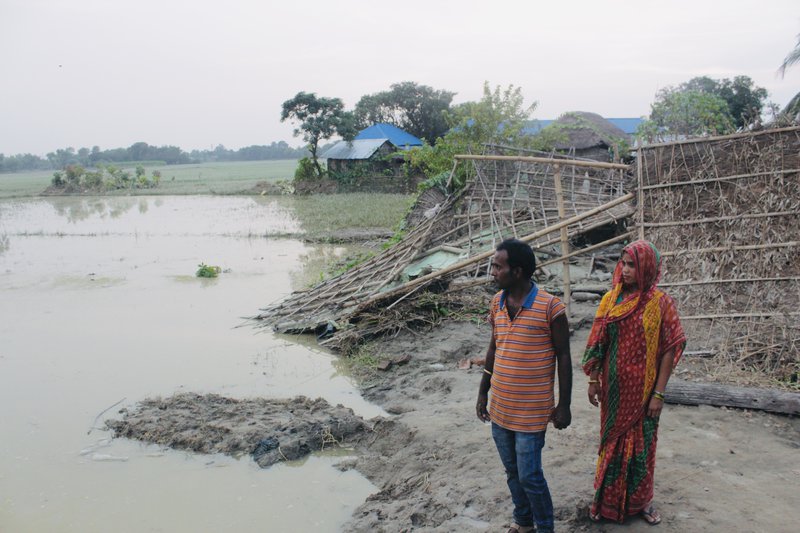
In the past, DRM support is mostly undertaken through a blanket approach. The spokesperson of the Ministry of Home Affairs Chakra Bahadur Budha said that the District Administration Office distributes a certain amount of cash to the affected people during floods and landslides for immediate purposes, based on the recommendations from the local level.
The government of Nepal and other humanitarian agencies have been distributing cash to the affected populations of disasters for a long time. The District Disaster Management Committee and District Administrative Office distribute a certain amount of cash to the affected populations as per the relief standards.
"In collaboration with UNICEF, Nepal Red Cross Society has been mapping and developing the data based on flood plain river basins of some of the municipalities for promoting SRSP," said Ramesh Ghimire, Cash Voucher Assistance (CVA) Coordinator of Nepal Red Cross Society. He further stated, “The SP database will be useful in establishing linkages to the banking system,” Ghimire.
Owing to the pandemic, and adverse effects of climate change, along with the increasing frequency, the severity of humanitarian crises, the elderly, marginalized and other vulnerable communities living in crisis-prone areas face greater exposure to shocks and stresses. SP, including cash transfer programs, can play a vital role in helping families to prepare, cope, and recover from shocks and stresses.
DCA's pilot project in Saptakoshi Municipality has shown that supporting the government at the local levels to use social protection systems to respond to the affected populations of disasters is an effective way to reach the people in need.
- MELAMCHI WATER SUPPLY: No Interruption During Monsoon
- Jun 25, 2025
- KOREAN RETURNEES: Successful Integration
- Jun 25, 2025
- UPPER TRISHULI-1: Engaging With Local
- Jun 25, 2025
- IME GROUP: Twenty Five Years Of Journey
- Jun 24, 2025
- NEPAL’S AIR POLLUTION: A Growing Health Concern
- Jun 24, 2025

